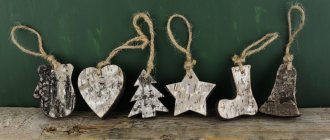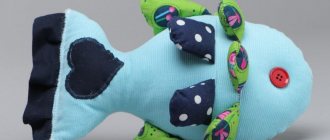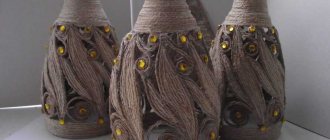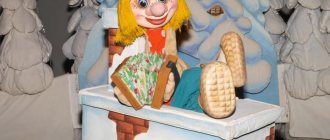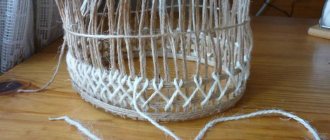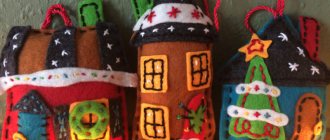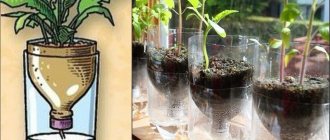Start
The whole procedure begins with choosing a suitable tree. Some people prefer to use freshly cut or fallen trees, others choose only living, growing ones.
But there is one common point - the tree with the least number of black spots on the bark, the so-called odorants, is selected.
They try to collect material from the south side, where the bark is most layered and easier to remove.
A little about the properties of natural materials
Birch bark is characterized by flexibility and technicality, charm and diversity. The material is very rich and quickly responds to the author’s idea.
- Reliability – along the fibers the material is incredibly strong, but if you take birch bark incorrectly, it will immediately break. Determining the correct direction is very simple, the lentils are visible to the eye and will indicate the required distribution of threads, just be careful.
- Elasticity - you need to feel the density, taking it in your hands you can feel how much it allows you to exercise with simplicity and grace.
- Elasticity - you can bend it without fear, no creases are formed.
Material procurement process
And so the tree has been selected, at the next stage it is necessary to correctly collect the material and deliver it to the place of work with it.
- Shallow cuts are made with a knife on the selected tree.
- The peeled part is carefully pryed off with any suitable tool, most often a spatula is used for this purpose.
- You should not expose a large area of bark on one tree, as this can lead to its illness or death.
- The resulting birch bark material is stacked face to face and back to back.
- It is bandaged and delivered to the place of further use.
- While the birch bark is pliable and not dry, it is split into strips or layers.
Harvesting can be done in several ways:
- Ribbons
- In layers
- Cylinders.
The easiest material to work with is tape; the tapes are intertwined in a certain sequence and create the desired product. This is exactly what a novice master should turn to.
There are two types of tape weaving:
- Straight
- Oblique.
How to make a birch bark box
To make a birch bark box, you need the following materials:
- 16 birch bark strips 1.7 cm wide and 50 cm long for weaving a box
- 16 birch bark strips 1.7 cm wide and 30 5 cm long for weaving the lid
- a pair of birch bark ribbons 1.7 mm wide. They are needed to decorate the Russian box
- frame made of tin seven mm wide and 40-5 cm long. It will be needed to strengthen the upper part of the product
- frame made of tin seven mm wide and 50 cm long. It is needed to strengthen the lid
- wood frame template.
First you need to weave an 8x8 pattern so that the inside of the Russian box is black. Later, a square bottom is formed, one side of which is equal to eleven cm. The walls rise to a height of two cells. Later, a wood template is installed and weaving continues to a height of four squares. As you go, you need to tighten the ribbons so that the box has four corners in accordance with the template.
At that time, at that time, at that time, at that time, at that time, when the 1st row of weaving is completed, the tin frame is put on the top of the product.
The edge is decorated by straight bending with paired ribbons. Later the 2nd sequence is braided. At the level of the 2nd cell from the top edge, a trim is placed that will not only decorate the Russian box, but will also hold its lid.
Take the ribbon prepared for finishing with the catchy side facing out. It is stretched with a pointed finish from top to bottom under the 2nd transverse, and later pulled up to the very finish. It is twisted so that the colored side is at the top and passed under the 3rd transverse one, after which it is pulled up. As a result, they take the first finishing triangle.
Later, the finishing ribbon is turned again, passed under the 4th transverse, and pulled up. A 2nd triangle emerges, but in a vertical direction. The finish of the ribbon is trimmed. Then take another finishing ribbon and insert it under the 2nd transverse one. They do the same with it as with the first ribbon. The resulting triangles should be located on the same level.
For the box lid you need 8×8 sheet. Its bottom is marked and a template board is installed. The walls are raised along it to a height of two cells. Later, a tin frame is put on, and the edge is decorated with a straight bend. Later they braid it a second time.
Your box is ready. Let him give you a good mood once a day!
Preparing material for work
The removed pieces of birch bark cannot be used immediately. It must be subjected to special processing. Proper processing of birch bark for crafts consists of the following steps:
- The first step is to clean the birch bark from dust, plant debris, dirt, as well as various irregularities; cleaning is carried out with fine-grained sandpaper.
- Moisten the underside using a sponge or soft cloth. It is important to carry out the procedure extremely carefully so as not to damage the material.
- Soaking birch bark in salt water for 2 - 4 days, the exact period depends on the age of the tree and the thickness of the material; the older the tree, the thicker the workpiece, the longer the soaking process takes.
- The soaked material undergoes delamination; it is disassembled layer by layer into thinner pieces.
- The last stage consists of drying, straightening (an iron is used for these purposes) and sorting by shape and appearance.
Now, knowing how to properly prepare birch bark, you can move on to making crafts from it.
Features of this material
Birch bark is a natural material that has been used in various types of creativity for quite a long time. It can be used both to create complex crafts and when making children's products.
It is pleasant to work with this material, although you need to know the features. So, birch bark is the upper, fairly elastic layer of birch bark. It has the following features:
- Easily withstands heat due to its layered, porous structure.
- Due to its flexibility, this bark is effective for manual processing.
- Able to pass air.
- Due to the peculiarities of the chemical composition, bacteria and pathogenic flora do not live in it and, accordingly, do not reproduce.
You can use birch material to make dishes or store food.
Tools
There are no special tools for working with birch bark material. Each master experiments and independently selects what will be more convenient for him to work with and sculpt masterpieces.
However, there are a number of tools that almost everyone uses.
- Knife or utility knife
- Scissors
- Clips or clothespins
- Ruler or corner
- Pencil
- Awl
- Hole puncher
- Staples
- Chisel
- Glue
- Dry, clean, soft cloths
Progress
Let's try to make a basket with our own hands.
To work you will need:
- birch bark (tape) 20 pcs, 45 cm each;
- sharp knife;
- There are many knives for work, which differ in size, purpose and shape. Use an awl with different rods, pliers and round nose pliers;
- A flat awl is a kocheldyk.
Related article: DIY beaded geranium
So let's get started!
- Let's start weaving a fabric that has a rectangular shape. Take four ribbons that you will pass through each other.
- This is how any weaving begins. To obtain the desired size of the product, you need to bend the tapes upward. It is worth remembering that the material is very whimsical and often curls. The unwinding technology is simple - pull the tape in your hand using the edge of scissors or a knife. Thus, the tape will twist in the opposite direction. This is how the bottom turned out.
- The difficult part is the handles for the basket. The diagram for them is presented below:
- Take aluminum wire, which will serve as a frame for the product. We formed an edge by passing wire inside. Start in the middle of the sides. Make the hem to the middle of the short side. Make a place for the exit by forming a clove. There should be several ends of wire coming out of its top. Make sure that the first is from the woven edge and the second is for the edge of the second side of the piece. Remember that the ends must be long.
- Handles connect both sides of the basket. Make the edge to the end, and then braid the product with a second layer.
- The handle can be made in several ways.
Method 1.
Can be braided using the tape itself. This method is quick and simple. Wrap two wires around to form a handle. Take a long ribbon, enough to cover the handle.
Method 2.
This is a weave of 2 ribbons. The technique lies in the size of the tapes. Their width is narrower than the tapes of the product, so take one long and narrow one. Place the strips on either side of the wire. Secure the third one near the base, braiding wide ribbons, securing them on the opposite side of the handles.
Method 3.
The most difficult way to weave. The top tape must be divided in half, intertwining between four stripes.
The box-basket looks good with a handle - a bookmark.
Note! You need to use four ribbons, weaving them into the base of the handle. Don't forget about the length of the ribbons.
Now you can look at the result:
This master class is perfect for beginners because it is quite detailed. This product may receive a difficulty level of two stars out of five.
Related article: Do-it-yourself fusing at home: master class with video
Birch bark crafts
In the old days, birch bark was used to make original shoes - bast shoes, kitchen utensils, and small jewelry.
Currently, its use has expanded significantly.
- Kitchenware
- Bijouterie
- Caskets
- Souvenirs
- Book bindings and bookmarks
- Flowers
- Toys and much more.
Now you can find many instructions for birch bark crafts of any complexity, both for experienced craftsmen and for beginners or children.
Just remember, the white side of the workpiece always remains inside the product, it should be hidden from view, because... Over time, it loses its appearance, becomes dirty and unattractive.
Birch bark and its properties
Birch bark is made from the top layer of birch bark. This layer is initially designed to protect delicate wood from insects, diseases, bacteria and excess moisture. Therefore, even when the tree has fallen and the wood has already begun to rot, the birch bark remains untouched and fresh for a long time.
Birch bark has a lot of useful properties:
- Antiseptic and antibacterial action
- Antifungal action
- It regulates humidity; birch bark containers always maintain their own microclimate
- Products in dishes made of this material do not spoil for a long time
- Birch bark is very elastic and flexible
- Has high strength
- Retains heat well
It is thanks to these properties that the material is used for various DIY birch crafts:
- Dishes
- Food storage boxes
- Baskets
- Children's toys
- Women's jewelry
Basket
How to make such a craft from birch bark with your own hands? The basket is one of the simplest crafts; it does not require special skills or special tools in its production, the main thing is to carry out all the actions extremely carefully and without haste.
- It all starts with preparing the workplace, material and necessary tools.
- A square is cut out of a birch bark blank, the size is chosen at will, but at the initial stage 15 - 16 cm will be enough.
- Next, two diagonal lines are drawn on the prepared square.
- At the next stage, identical cuts are made on the workpiece from the corners along the drawn lines; the depth of the cuts should be at least 3 cm. It is worth remembering that the larger the cuts, the deeper the finished product will become.
- The sides of the workpiece are smoothly bent towards the middle.
- Next, the hole punch comes into play; with its help, holes are made along the perimeter of the walls of the basket and at the bottom at the base of its future handle.
- The handle of the craft is cut out in any desired shape; for this, another piece of birch bark is taken.
- Using PVA glue (or any other) it is glued to the side walls; for stronger fixation, the joints can be secured with special clamps or clothespins.
- Thin strips are cut from birch bark strips so that they fit into the holes left by the hole punch.
- Such thin strips are woven around the entire perimeter of the product.
- The finished product is set aside for several hours until the glue has completely dried.
- If desired, the finished basket can be wiped with oil and wait until it is absorbed; this procedure will give additional shine and a sunny tint to the birch bark.
- All! The product is ready for use.
Handmade birch bark crafts have a special warmth and attractiveness and leave almost no one indifferent.
A little history
Archaeologists have carried out quite a lot of archaeological excavations, during which many interesting facts have been established about the use of bark in ancient times. Birch was treated with respect and the tree was endowed with unusual properties.
Interesting finds have been discovered all over the world. Birch bark items were found in the tomb of Tutunkhamun in the 14th century BC. e., scientists were amazed at the skill of the people who lived in those days. Slotted bark was found on capes decorating the quivers of Scythian warriors. This find is dated to the 2nd millennium BC. e.
Letters created from the bark of this tree are considered an amazing discovery by archaeologists. With the help of such letters they conveyed information and left messages for us. This made it possible to learn a lot of interesting things about life in Ryazan, Novgorod and Smolensk in the 11th-14th centuries. Sticks made from small animal bones were used for writing. With their help it was possible to scratch letters on the surface of the bark.
An unusual birch bark book containing prayers was found in Novgorod. It consisted of 12 pages and was written at the end of the 12th century. The book lay underground for about 800 years and was preserved. Thanks to such strength, a lot of interesting information about the life and way of life of our ancestors has survived to this day.
Photos of birch bark crafts
Where is birch wood used?
The color of birch wood is the lightest of all. It is usually white with a yellow tint. Heart-shaped rays are visible on the radial split. They are usually shiny and short. The texture is uniform and fine. At the same time, it cuts well.
However, there are special measures to preserve the shape of the product. So, dried birch must be soaked in vegetable oils. This will help preserve the product longer.
The physical characteristics of birch wood indicate that it is a rather fragile material that is susceptible to changes under the influence of moisture. This is why birch is rarely used for wall cladding; in construction, solid birch is given the role of flooring.
We recommend reading: DIY bird feeder - building beautiful and functional models
In applied arts, various products are made from it, however, only in small forms. Maximum use of birch wood is possible when sawing it, then plywood is made from sawdust by pressing. Birch is also used in the manufacture of skis, knife handles and ax handles.
Products and counterfeits
The softness of birch is used by all masters of decorative and applied arts. Dried pieces of wood of any shape are sanded well, and then whole panels are cut out using a cutter. After this, the finished product is dipped in hot oil and kept in it for at least 4-5 hours.
The bark is also used very actively in creating crafts. Birch bark is removed from a fallen tree at the end of spring. At this time, its inner side (which is considered the front side by the craftsmen) has a golden hue. The birch bark is dried naturally, possibly under pressure, and then, if necessary, it is laminated.
Thick bark is used to create flat crafts, and thinner birch bark is used to make three-dimensional products, for example, tues. Such crafts are usually durable and at the same time have amazing properties. For example, a birch bark container can store milk for a long time, and at the same temperature at which it was poured into it.
Artwork made from Karelian birch wood:
Reviews from craftsmen who work with wood are often positive. So, Yuri from St. Petersburg says the following. It is easy to make crafts for the kitchen from birch. They turn out beautiful; if you bleach the birch, the product even looks aged. Irregularities after the knife can be easily corrected by changing the design of the product. I try to always have a supply of birch for crafts.
It is easy to work with birch, the products turn out beautiful and, if dried correctly, will be durable. This wood is great for beginners. All crafts also have a special aura.
Furniture board
Gluing parts of birch into one common piece is called a shield. Typically wood waste is used for this.
Shields are:
- multilayer,
- three-layer,
- economical.
Their use, and therefore their production, is determined by their thickness.
Sufficiently thin panels are used only for inserts into the main body of furniture. More durable boards are used to create decorative planes. For seat backs, sheets are used that have been pressed in a special way in metal forms.
Furniture board made of birch, provided that sufficiently environmentally friendly glue is used, has a number of significant advantages. Among them are strength, safety and shape retention throughout the entire period of use.
Birch wood furniture
Considering that birch is highly susceptible to rot, most often when creating furniture it can be used as a base for plywood or as crafts for decorating soft or wooden products. At the same time, to create veneer, you can use any type of birch wood, you just need it to be dry and disease-free.
Almost all furniture in the mid-price category is made from plywood of varying thicknesses. It can be:
- Tables, chairs.
- Kitchen sets.
- Hall or any other walls.
- Dressers, drawers, doors.
- Stair steps.
Higher quality plywood makes it possible to produce fairly strong structures that can last a fairly large number of years without contact with moisture. Although this period is still incomparable with the years of operation of wooden products.
But in the production of decorative overlays for furniture, it is preferable to use Karelian birch wood (it is as strong as possible). Another valuable property of birch is also valuable here - the ability to accept any color well, which allows using birch wood to create an imitation of products from more expensive types of wood.
Array
Several stages of proper processing, as well as following special drying methods, can significantly strengthen the structure of solid birch. This tree has antibacterial properties, which, together with the generally recognized positive aura, make it possible to make a wide variety of furniture from solid birch.
The smooth texture of birch and its good natural color make it possible to use solid wood without painting, but only with the application of a protective layer. Sometimes birch wood is bleached, thus emphasizing its interesting texture. If the solid wood is painted, it can imitate different types of wood.
Karelian birch is used to make various products and good furniture. It is believed that a bed made from solid wood can last at least 30 years, and a set, for example, for a children’s room, even longer. Other types of it can also be used as solid wood, but then the service life of such furniture will not exceed 10-12 years.
Sergey from Tomsk, a specialist in furniture making, says that expensive and high-quality furniture can be made from birch: I make boards from solid birch myself, dry them, and then use them in the production of furniture walls. The products turn out beautiful, their cost is several times cheaper than from other solids, and the strength is quite acceptable.
When properly processed, wood eliminates all its shortcomings and quite expensive, beautiful and durable furniture, as well as doors, tables, chests of drawers and stairs, can be made from its solid wood.
We recommend reading: DIY crafts from waste materials: instructions, options, types of materials
Round timber
In this form, birch wood is used not only for firewood.
Round wood is used for:
- railway maintenance;
- manufacturing parts of horse-drawn carts;
- securing roofs in the mining industry;
- arrangement of cages for birds and animals.
They make from round timber:
- Stakes. Their thickness should be from 5 to 8 centimeters with a length of 2.5 to 3 meters. The stakes are installed to support shields that protect roads and railways from snow.
- Shafts, spreads, beds of thin round birch timber are the side parts of horse-drawn carts. The thickness of the round timber in this case usually does not exceed 11-15 centimeters. The length depends on the tasks assigned to the cart.
- Mine racks. This is a round piece of birch, sharpened on one side, like a pencil. It easily enters the mine rock and is able to withstand heavy roof loads. The length of the round timber depends on the thickness of the coal seam, and the standard width should be a minimum of 12 centimeters, a maximum of 35.
- Poles. They are made from thin round birch wood to be used in cages, for example, for parrots. You can also make a fence from poles. The poles should be free of knots and fairly thin. The thickness of one pole is from 1 centimeter and should not exceed 10.
There are no great quality requirements for round timber. It is important that such timber does not have large knots, wormholes and rottenness inside the trunk, as well as cracks. Also, the round timber should not have much curvature.
What types of wood are mugs made from?
The materials used are coniferous and deciduous species:
- Oak is resistant to moisture and cracking. Depending on age and drying temperature, it acquires different natural shades. The most durable is bog oak, kept in water for several decades.
- Ash is valued for its noble color and durability. The structural pattern is pronounced.
- Tropical acacia is valued for its delicate aroma; it can be felt even under a layer of varnish. The structure of the wood is patterned, several shades of beige, some almost white.
- Bamboo is both light and durable; it makes thin-walled cups, tea pairs with turned saucers and stands. Bamboo has antiseptic properties, is moisture resistant, and resistant to shock loads.
- Linden is chosen for carved handles. The wood is pliable and resistant to cracking.
- Birch is used for massive forms; massive containers with a wide bottom are turned from it. The design is burned onto the birch tree and then filled in with paint.
Less commonly, dishes are made from cherry, cedar, pear, unabi, spruce, lotus wood, jujube, and hevea.
What can you drink from wooden mugs?
Dishes are used for cold and hot drinks. Green tea is served in elegant cups made of dense wood. Kuksa is universal, it is a cup and a plate at the same time. In camping conditions, soups are poured into it, porridge is laid out, tea and milk are poured into it.
A wooden tea mug does not heat up, and the drink remains hot for a long time.
Note! Kuksa was never considered a beer vessel; it is used for food, not for entertainment. Giving a Finnish mug to beer lovers is bad manners.
Large mugs were previously considered containers for kvass and mead. Now this is beer glassware. It is not customary to drink other alcohol from wood. Alcohol dries out the surface of the varnish, making it brittle.
Wooden utensils are a unique product into which you can pour both hot and cold liquid.
Note! To impregnate wood, a special food varnish is used, which darkens from colored carbonated drinks. The dye gets into microcracks in the surface layer.

